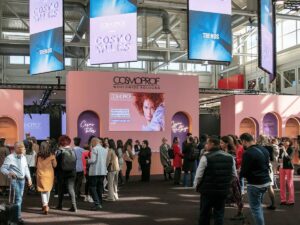Wondering how to stay ahead in the dynamic world of cosmetics manufacturing? Discover the important role trade shows play in fostering innovation, networking, and business growth.
With years of experience going through the growing aisles of global cosmetic manufacturing trade shows, I bring a wealth of insider knowledge and practical advice.
Cosmetic manufacturing trade shows are not just events; they are the beating heart of the industry’s future, showcasing the latest trends, technologies, and partnership opportunities.
In this ultimate guide, we’ll dive into the why, how, and what of making the most out of these trade shows, from planning your visit to following up on leads.
Read on and stay ahead!
Cosmetic Manufacturing Trade Shows serve as a crucial nexus for industry professionals to converge, share insights, and uncover the latest innovations shaping the beauty landscape. These events are strictly designed to facilitate networking, learning, and the discovery of new products and technologies that can transform business operations.
Attendees gain unparalleled access to a wealth of knowledge, from cutting-edge ingredients to emerging market trends, directly from experts and thought leaders. Moreover, these trade shows are not just about exhibition stands and product samples; they are dynamic platforms for forging lasting business relationships.
Through workshops, seminars, and one-on-one meetings, companies can engage with suppliers, distributors, and potential partners, laying the groundwork for future collaborations and strategic alliances. This environment fosters a community of forward-thinkers, all dedicated to pushing the boundaries of cosmetic science and product development.
Building on the importance of staying connected and informed through cosmetic manufacturing trade shows, it’s essential to know which events stand out on the global stage. Let’s break down the top events where innovation meets opportunity:
As we delve into the world of cosmetic manufacturing trade shows, it becomes clear that these events are not just about observing the latest trends and innovations. Here are the key networking opportunities to find:
Many trade shows offer pre-scheduled business-to-business (B2B) meetings, allowing attendees to book appointments with exhibitors, suppliers, and distributors before the event even starts. This ensures that you can maximize your time at the show, meeting with potential partners. For example, a startup skincare brand might schedule meetings with packaging suppliers and formulation experts to discuss specific projects.

Workshops and seminars are not just educational but also networking hubs. Presenting a chance to engage with speakers and attendees who share your interests, these sessions can spark conversations leading to collaborations and new business opportunities. Likewise, participating actively or asking questions during these events can make you memorable, fostering connections that extend beyond the trade show.

Trade shows often host social events and receptions, which provide a more relaxed environment for networking. These gatherings are perfect for informal introductions and conversations that can lead to meaningful business relationships. Aside from that, mingling in such a setting allows for the exchange of ideas and experiences without the formalities of a business meeting, opening doors to collaborations and more.
Venturing onto the trading floor of a cosmetic manufacturing trade show is like stepping into a live market research report. Let’s see how these insights manifest and how they can be harnessed for the brand’s growth:
One of the most direct ways to gather marketing and branding insights is by observing how companies showcase their products. Innovative presentation techniques can significantly attract attendee interest. Nako Cosmetics demonstrates its product offerings through live demonstrations and client interaction, allowing potential buyers to experience the quality and effectiveness of their products firsthand.
The trade floor is a battleground for brand visibility and appeal. By analyzing competitors’ booths, marketing materials, and engagement tactics, you can gain valuable insights into industry standards and innovative marketing strategies. Moreover, this environment offers a unique opportunity to assess what works and what doesn’t, enabling you to refine your own marketing approach.
Trade shows are hotspots for trend spotting, with brands often launching new products and technologies to gauge market reaction. By paying attention to these launches, you can discern patterns in consumer preferences and emerging ingredients that are gaining traction. Similarly, this real-time market feedback is important for anticipating shifts in the beauty landscape, allowing brands to stay ahead of the curve.
While cosmetic manufacturing trade shows offer unparalleled opportunities for growth, networking, and learning, they also present a set of common challenges. Let’s explore the most frequent challenges:
The sheer size and scale of major cosmetic trade shows can be overwhelming, making it challenging to cover all relevant booths, attend key seminars, and network effectively. A strategic plan is crucial which is why attendees should prioritize their objectives, research the exhibitors and events in advance, and schedule their time efficiently to ensure they can engage with key stakeholders and not miss out on valuable opportunities.
For exhibitors, one of the biggest challenges is distinguishing their booth from hundreds of others. Nako Cosmetics, with its diverse product range, utilizes distinctive branding and interactive demonstrations to capture the attention of passersby. Nonetheless, creating an engaging and memorable booth experience can help companies stand out and attract more visitors.

Logistics, from transporting products and setting up booths to managing staff and scheduling meetings, can be daunting. It’s essential to plan logistics well in advance, considering factors like shipping deadlines, booth design requirements, and staff training to ensure a smooth and efficient trade show experience.
Quantifying the return on investment (ROI) from trade show participation can be challenging. Companies should set clear objectives, whether it’s generating leads, building brand awareness, or establishing partnerships, and use specific metrics to measure success post-event. Additionally, this might include tracking leads generated, contracts signed, or the increase in brand engagement on social media.

After overcoming common challenges at trade shows, the next step is to harness the wealth of knowledge and insight they offer. See the following trends that are shaping the cosmetic manufacturing landscape:
A dominant trend emerging from trade shows is the industry-wide shift towards sustainability and eco-friendly manufacturing practices. Brands are increasingly showcasing biodegradable packaging, natural ingredients, and cruelty-free products to meet the growing demand for environmentally responsible goods. As per FMI data, the global biodegradable packaging market is anticipated to register a CAGR of 6.1% during 2022-2032.
Personalization is another significant trend, with companies leveraging technology to offer customized beauty solutions. On top of that, advanced skin analysis tools, AI-driven product recommendations, and on-demand formulation systems are just a few examples of how brands are moving towards creating personalized customer experiences.
Here’s a table that highlights the role of personalization and customization in the beauty industry, showcasing how technology is used to create tailored customer experiences:
| Aspect | Description | Benefit |
| Advanced Skin Analysis Tools | Devices and software that assess skin type, conditions, and needs to recommend specific products. | Targeted Solutions: Provides customers with product recommendations tailored to their unique skin concerns. |
| AI-Driven Product Recommendations | Artificial Intelligence algorithms analyze customer data to suggest products. | Efficiency and Accuracy: Offers fast and precise product suggestions based on customer profiles and preferences. |
| On-demand Formulation Systems | Technology that allows for the creation of customized beauty products in real-time. | Uniqueness: Enables customers to have beauty products created specifically for their needs, enhancing satisfaction. |
| Personalized Customer Experiences | The overall strategy of using technology to cater to individual customer preferences and needs. | Customer Loyalty: Fosters a stronger connection between brands and customers, encouraging repeat business. |
The integration of digital technology into product development and client engagement strategies is a key trend. From augmented reality (AR) makeup trials to blockchain for product traceability, technology is playing a crucial role in enhancing the experience and ensuring product authenticity. These innovations not only improve client satisfaction but also offer new ways for brands to interact with their audience, gather data, etc.
For some insightful reads, we’ve curated a list of recommended articles just for you:
Still haven’t found what you’re looking for? Don’t hesitate to contact us. We’re available around the clock to assist you.
To wrap it up, the world of cosmetic manufacturing trade shows can significantly elevate business, providing insights into emerging trends, networking opportunities, and innovative marketing strategies. This guide aims to equip you with the knowledge to make the most out of these invaluable events.
If you are interested in exploring how Nako Cosmetics is leading the way in beauty innovation, discover our range of products and see how we can enhance your offerings. For more information, contact us today!
Own Your Private Label Cosmetic Line Is No Longer Difficult Here!
Don't let questions and needs hold you back. Reach out to us today.
How to Start Your Beauty Business?